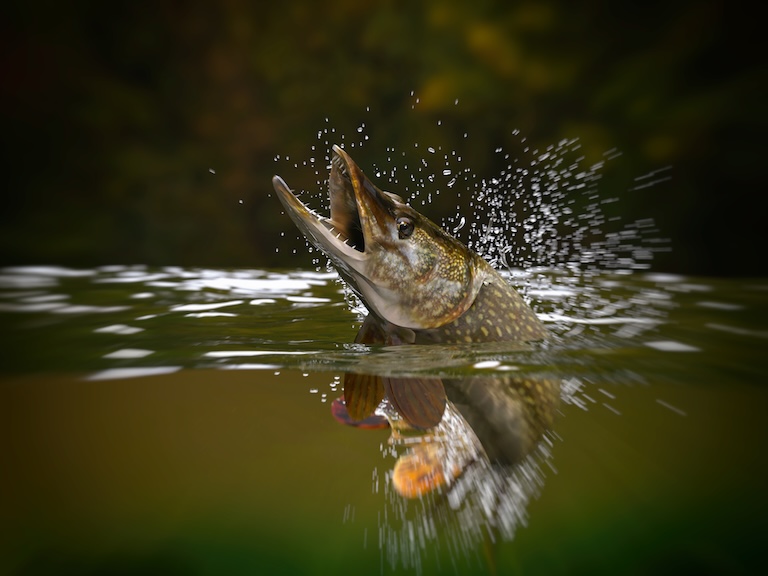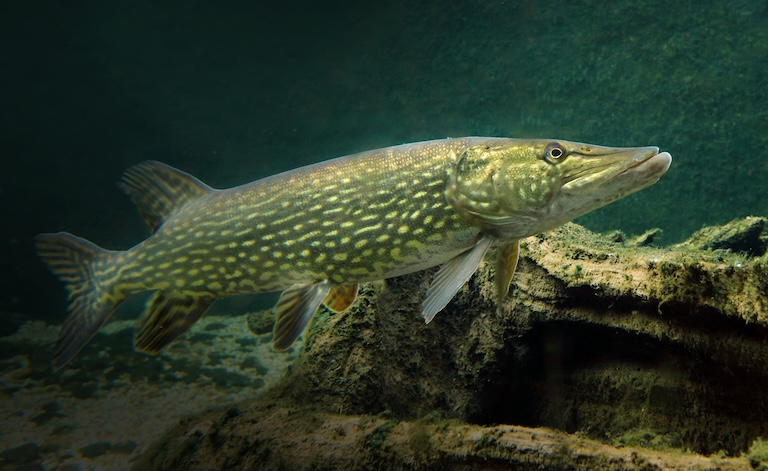Northern Pike Profile
When presented with the opportunity to form a meta quote, no one should ever turn it down:
“‘They are mere machines for the assimilation of other organisms’ – George Brown Good, Natural History of useful Aquatic Animals, 1884
“With the exception of Homo Sapiens, there is perhaps no other species so dedicated to gluttony as Esox Lucius, the Northern Pike… [It] is a voracious feeder that finds most creatures – even squirrels and sandpipers – fair game.” – Maureen Mecozzi of Wisconsin’s Bureau of Fisheries Management, 1989

Northern Pike Facts Overview
| Habitat: | Adaptable to a variety of freshwater systems |
| Location: | North America and Eurasia |
| Lifespan: | Up to 12 years |
| Size: | Up to 150 cm (59 in) long |
| Weight: | Up to 25 kg (55 lb) |
| Colour: | Olive green, mottled and spotted |
| Diet: | Invertebrates when young, larger fish when mature, and sometimes even mammals |
| Predators: | Other pike, humans, sometimes otters |
| Top Speed: | Possibly up to 16 km/h (10 mph) in bursts |
| No. of Species: | 1 |
| Conservation Status: | Least Concern |
Northern pike are a cool water species in more ways than one. These temperate and cold-region, freshwater predators are sleek, camouflaged and ferocious.
And they can get worryingly large. They have very small brains, but what they lack in philosophy they more than compensate for with brute force and rapid bursts of speed.
Pike are related to the Salmon order, but while the latter is a marathoner, the pike is a drag racer, lunging at its victims from a standstill, and using its highly specialised, spear-like form and tubular body to punch holes in animals up to a third of its own length.
Interesting Northern Pike Facts
1. They’re Esociformes
This small order of freshwater fish only contains two families. It’s a sister order to the Salmoniformes, or salmon-like fish – the most salmon-like of these being the salmon – and shares a superorder with them, or in some circles, even is listed as the same order.
Pike are members of the Esocidae family, all of which are found in the cool waters of the Northern Hemisphere, and unlike the highly migratory salmon, these fish tend to stick around, lurking in the weeds before darting out to kill things.
The Northern pike’s genus, Esox, contains seven extant species, with the North American muskellunge being the largest, weighing up to 32 kg. The Northern pike, though slightly lighter, is no less ferocious.

2. They’re ambush predators
The pike is a perfect example of an animal whose body is the perfect weapon. This long, cylindrical fish is lined with muscle down its flanks and tipped at one end with a set of powerful fins and a thick, symmetrical caudal fin.
This is not a form built for stability, but one built for acceleration, with all the energy pushing from the back, sending the front towards its prey as quickly as possible. But between bouts of terrifying speed, it hangs apparently motionless in the water, using only the last fin rays of the greatly pushed-back fins to maintain position.
Then, when it’s time to lunge, it uses its elasticity to generate thrust with the rearward fins acting in support to send a wide, duck-billed mouth full of rows of teeth towards its victim.
These fish have large eyes and bony, armored mouths to find prey in the shallow water and battle against its defenses. 1
3. They’re adaptable
This strategy works well on its main diet of fish and frogs but its size means the fish is capable of taking mammals and birds, and this is part of the reason for its success in various waterways across the northern Hemisphere.
Northern pike are found in almost every type of freshwater system, from cold, deep lakes, streams, and rivers, to muddy ponds. They are tolerant of a range of oxygen levels, meaning they can thrive in areas other predators can’t.
And there is no bigger freshwater predator in most of the Northern pike’s range, making it top dog. Its only true enemies are other pike. 2
4. They fight
This is an aggressive fish, especially when feeding, and large individuals will often lay into smaller ones both in defending their territories and in acts of cannibalism.
As soon as the ratio of predator to prey reaches 2:1 the scarcity of food drives this species to turn on one another.
Young pike are also vulnerable to having their kills stolen by older members of the species, and this creates a negative trend between the amount of undergrowth and the size of the pike in the area: smaller pike require more places to hide, while larger individuals boldly venture into uncovered waters.
These large pike have very few enemies and have even been known to attack dogs, but even these monsters show recognisable duck-billed scarring from attacks by their rivals, and fighting among mature individuals seems common. 3

5. They’re not venomous
There’s a common rumour going around that the seemingly excessive bleeding people experience when bitten by a pike (that they’ve caught on a line) is caused by an anticoagulant in their saliva.
This appears to be entirely baseless, in terms of research done on it, so the bleeding is just as likely to be a product of the rows of sharp teeth causing multiple cuts at once.
This rumour may turn out to be true, but considering the animal’s hunting style and ecological role, it seems like an unnecessary adaptation, so it’s safe to cast doubt on this one for now.
Fishermen aren’t the most reliable of sources, and many even go as far as to call the pike evil, which seems a bit unfair, considering how they’re pulling it out of its home by a hook in its face. 4
6. They used to be a delicacy
There are quite a few good examples of the arbitrary nature of human fashion. Lobsters, the bottom-feeding arthropods made of flaky goo were once understandably fed to prisoners and slaves, being hugely abundant and altogether low-grade food.
Caviar, too, was the poor man’s solution to a lack of refrigeration and access to premium cuts.
Believe it or not, even oysters, those delectable shells of fishy, congealed seminal fluid, were considered poor-quality food until shifts in fashion, often driven by scarcity, elevated them all to the highest ranks of social status signalling.
Pike went the other way. Medieval royalty in Britain was, much like the pike itself, keen on more or less every animal they could stuff into their swollen bellies, Henry VIII being the most iconic in this regard. Old Henry would have pike for breakfast, but in the time since, it sort of fell out of fashion.
This may have something to do with how many bones are found in the meat, or it could just be a case of something being so abundant it doesn’t make the eater feel special anymore. And pike are certainly plentiful.
7. They’re abundant
It’s always great to find an animal doing well in our freshwater systems. As the industrial impacts on fresh water all over the globe are contributing to declines in any number of aquatic animals, it can be great news to hear of some that are doing well.
The adaptability of pike to various habitats and its diversity in diet means this generalist predator is still doing well, with a stable population and of no conservation concern.
In a twisted bit of luck, they’re also highly sought-after by fishermen, which alone is likely enough to secure their future.

Northern Pike Fact-File Summary
Scientific Classification
| Kingdom: | Animalia |
| Phylum: | Chordata |
| Class: | Actinopterygii |
| Order: | Esociformes |
| Family: | Esocidae |
| Genus: | Esox |
| Species: | lucius |
Fact Sources & References
- Pospisilova, A (2019), “Embryonic and larval development of the northern pike: An emerging fish model system for evo-devo research”, Sci Hub.
- Ryan Lefevre, “Esox lucius American pike”, Animal Diversity Web.
- Dan Bross (2022), “‘Programmed to eat’: Northern pike mauls husky at North Pole gravel pit”, Publication.
- dickderriks88 (2008), “pike attacks man”, YouTube.
